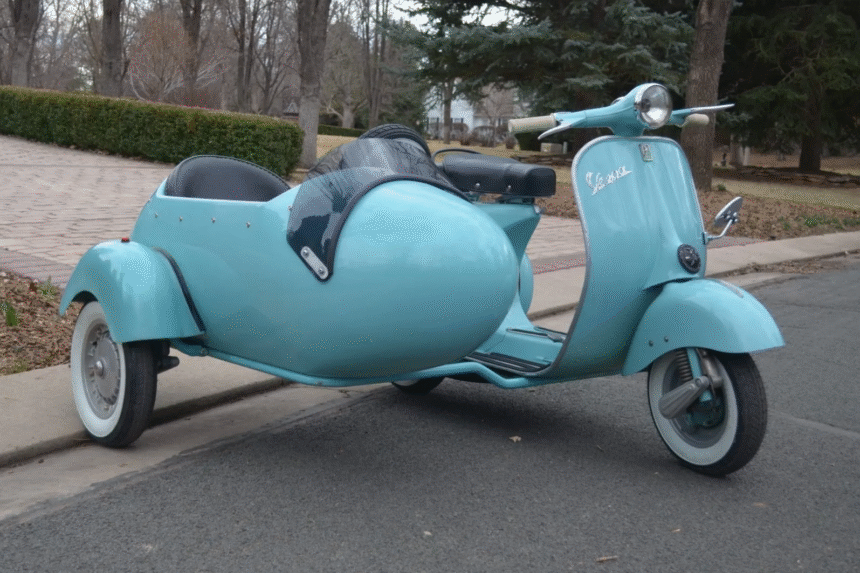The vintage scooter with sidecar is a timeless icon that perfectly merges nostalgic charm with practical functionality. From its early designs in the mid-20th century to modern reinterpretations for today’s riders, the scooter with sidecar carries both history and personality on the road. For enthusiasts and collectors alike, these scooters represent more than transportation; they embody a lifestyle.
The Origins of the Scooter with Sidecar
The concept of attaching a sidecar to a motorcycle or scooter dates back to the late 19th and early 20th centuries. The sidecar was first conceptualized as a way to transport additional passengers safely without sacrificing the nimbleness of two-wheelers. Early patents and designs, like those from French inventor Jean Bertoux in 1893, laid the groundwork for what evolved into a popular mode of travel and utility.
Vespa, the world-renowned Italian scooter brand, introduced its first sidecar models between 1948 and 1949. These sidecars were crafted from sheet steel and manually assembled, enhancing scooters’ capacity and stability significantly. Vespa’s sidecar scooter became celebrated for its ability to comfortably handle long-distance travel, even in challenging terrains such as snowy or steep slopes.
Iconic Vintage Models and Their Legacy
Several scooters with sidecars became collector’s items due to their innovative design and cultural significance.
-
Vespa 150 Sidecar (Late 1940s–1950s): One of the earliest successful models featuring a steel-built sidecar attached by a single tube. It was praised for stability, comfort, and additional trunk space—ideal for family outings or weekend travels.
-
Salsbury Model 85 (1947–1950): Known as the Buck Rogers rocketship of motor scooters, this American-made scooter had futuristic styling and practical sidecar options, marking an early milestone in scooter innovation.
-
Fuji Rabbit Superflow S601 (1965–1967): Unique with its automotive-style fluid torque converter and electric starting, this Japanese scooter made waves in the vintage scooter world with smooth handling, often paired with sidecars.
-
Ducati Cruiser (1952): Styled by Carrozzeria Ghia, this model was a standout as the first with a four-stroke engine and automatic transmission, sometimes equipped with sidecars for enhanced transportation.
-
Heinkel Tourist (1953–1965): A robust German scooter known for its durability and comfort, often paired with sidecars for two-up touring across countries.
These models demonstrate how manufacturers focused on merging style with advanced mechanics, resulting in scooters ideal for both daily use and leisurely travel.
Why Vintage Scooters with Sidecars Remain Popular
Vintage scooter enthusiasts are drawn not only to the aesthetic appeal but also to the distinct riding experience and historical value.
-
Classic Design: The sleek lines, rounded edges, and chrome accents evoke an era where form met function with elegance.
-
Enhanced Stability: Adding a sidecar provides three-wheel stability, making these scooters uniquely accessible even for less experienced riders.
-
Community and Culture: Owning a vintage scooter with sidecar often opens doors to clubs, rallies, and shows that celebrate scooter heritage worldwide.
-
Customization Potential: Many riders restore and customize vintage sidecars, combining modern technology with classic looks.
-
Sustainable Transportation: Restored vintage scooters contribute to eco-friendly commuting, especially when retrofitted with modern electric powertrains.
Modern Comforts in Vintage Style
Today’s vintage scooter with sidecar models often combine classic design with modern amenities. New builds or restored models now feature:
-
Improved suspension systems for smoother rides
-
Advanced braking technologies for safer stops
-
LED lighting for enhanced visibility
-
Electric start and fuel injection for convenience
-
Optional electric sidecars for eco-conscious riders
This blend of old and new satisfies both collector desires and practical daily commuting needs.
Maintenance Tips for Vintage Scooter with Sidecar Owners
Owning a vintage scooter with sidecar requires attention to mechanical upkeep. Here are essential maintenance tips:
-
Regular Inspection: Check sidecar mounts, suspension, and frame integrity frequently to avoid instability issues.
-
Engine Care: Maintain engine tune-ups, oil changes, and carburetor cleaning to preserve performance.
-
Electrical System: Vintage wiring can degrade; upgrading to modern harnesses ensures reliability.
-
Tire Condition: Use tires suited for three-wheeled dynamics and inspect for uneven wear.
-
Storage: Proper storage prevents rust and corrosion, especially on the sidecar’s metal body.
Proper care ensures these classic machines remain reliable and beautiful for decades.
Buying and Collecting Vintage Scooter with Sidecar
Purchasing a vintage scooter with sidecar requires understanding the market and what to look for:
-
Authenticity: Verify original parts versus aftermarket replacements.
-
Condition: Assess rust, frame damage, and mechanical wear.
-
Provenance: History of ownership and maintenance can add value.
-
Restoration Level: Decide if you want a fully restored vehicle or a project scooter.
-
Legal Requirements: Check local regulations for antique vehicle registration and insurance.
Collectors often refer to dedicated resources and forums for guidance and support on acquisitions.
High-Authority Resource for Vintage Scooters
For detailed information and community-driven advice on vintage scooters with sidecars, Vespa’s official history page and comprehensive vintage scooter forums offer invaluable knowledge. The Vespa timeline highlights breakthroughs in sidecar designs and their cultural impact, providing enthusiasts with rich historical background and technical details.
Official Vespa history reference: Vespa Vintage Models Timeline
Conclusion
The vintage scooter with sidecar remains a fascinating blend of retro aesthetics, unique riding experiences, and modern enhancements. Whether as a collector’s prized possession or a stylish yet practical ride, these scooters offer unmatched character on the road. Their enduring appeal highlights a successful balance between classic design and contemporary comfort, ensuring that scooters with sidecars continue to captivate riders well into the future.









